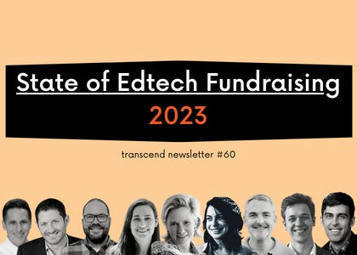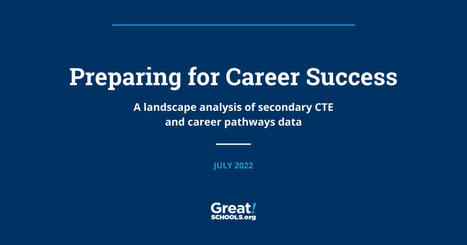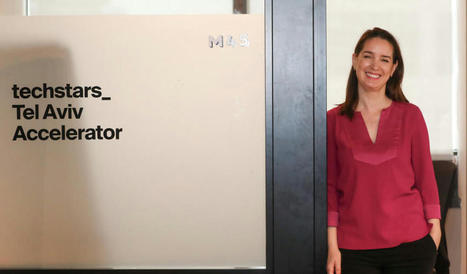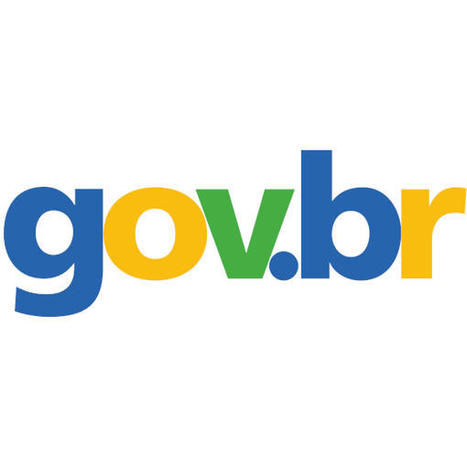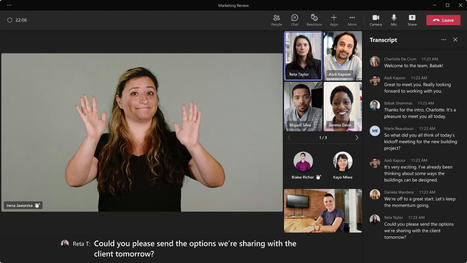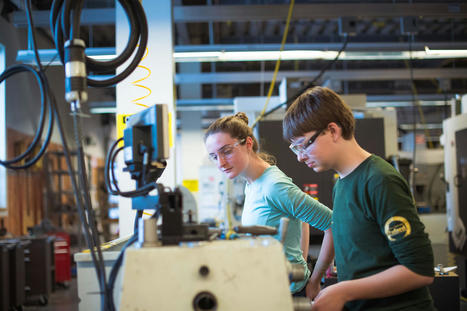 Your new post is loading...
 Your new post is loading...
Focado em startups early stage, novo fundo de venture capital terá também Gilberto Sayão e Duda Melzer entre os investidores. Ele será tocado por Luis Felipe Magon e Mauricio Feldman
Algorithms that create art, text, and code are spreading fast—but legal challenges could throw a wrench in the works.
Para obter retornos da IA, organizações precisam de um relacionamento multidimensional com a tecnologia, que passa pelo valor individual do seu uso percebido por cada funcionário
It’s time for our country to reckon with itself on the deeply held value of education. Is it education that we value? Or is it the credential that results from certain types of education? We have lived in a society that has emphasized the importance of education from the very beginning. Benjamin Franklin once said “an investment in knowledge pays the best interest.” A similar refrain has been made by nearly every American leader since and reflected by generations of Americans at dinner tables across the country. On the surface, there’s nothing to argue about. Education, broadly defined, is among the most worthy goals of any democratic society. But lurking beneath the surface is a real crisis of conscience for our education system as to whether it values education and learning or simply the credentials that accrue from it. At the core of this are colleges and degrees.
Colleges and universities do indeed suggest they value education; for example, ‘lifelong learning’ is one of the most common phrases in college mission statements. But they don’t reward lifelong learning in any way. They only reward the learning that comes in the form of degrees – 2-year, 4-year and post-graduate. They don’t provide recognition and credentialing for just one year of college nor – for those pursuing bachelor’s degrees – for two or even three years of education. Aside from a vaguely defined movement on the part of some colleges to offer “certificate” programs, there isn’t much that structures alumni lifelong learning in a formal way either. In reality, lifelong learning is more a myth than an outcome that has been achieved.
For the past several decades, champions of education have run well-meaning campaigns to improve college attainment by setting degree completion goals at both the federal and state level. Amidst the push for college attainment goals, there have also been a number of unintended consequences and negative externalities. Namely, we have greatly devalued the vocational training that has long been a staple of American education. Career and technical training in American schools has greatly receded. Worse, we have created a judgmental attitude about career and technical education – treating it as a ‘second choice’ alternative to college. Have college completion campaigns truly encouraged a spirit of learning and a ‘learn ethic’ among Americans? Or have we conflated education with degrees to an extent that a degree is the only ‘acceptable’ form of education?
In Michael Sandel’s new book “The Tyranny of Merit,” he suggests that our overzealous belief in meritocracy has led us to a point where we have created a toxic politic of credentialism as “the last acceptable prejudice” in America. He points explicitly to American higher education as a source of this; elite universities, in particular, have created an obsession with selectivity that has led to ‘fevered striving’ among students who focus simply on grades and test scores rather than sincerely engaging in education. He notes that, “…the regime of merit exerts its tyranny in two directions at once. Among those who land on top, it includes anxiety, a debilitating perfectionism, and meritocractic hubris that struggles to conceal a fragile self-esteem. Among those it leaves behind, it imposes a demoralizing, even humiliating sense of failure.” In essence, he argues that the value of the education in college classrooms is now lessened by students’ obsessive focus on achievement; while at the same time, few of us bother to recognize all the valuable learning that takes place outside of college classrooms and beyond college campuses.
Sandel also notes the massive differences in investments made at the federal level between subsidizing degree-based education through colleges and universities and labor market training for career and technical education. In 2014-15, The U.S. spent $162 billion supporting degree-based college education while the Department of Education spent a mere $1.1 billion on career and technical education. Further, U.S. investment in labor market programs pales in comparison to other advanced countries who spend an average of 0.5% of GDP in this area. The U.S. spends only 0.1%.
Much of our rhetoric around college vs. career and technical education is that of an ‘either/or’ framing as opposed to a ‘both/and’ opportunity. In essence, we treat it as a binary choice. One either goes to college (the preferred route) or they take the less desirable alternative of career and technical training. In addition, we think of aspects of education such as ‘critical thinking,’ a liberal education and civic education as exclusive only to colleges and universities. But Sandel questions this as well by asking,“…why assume that colleges and universities have, or should have, a monopoly on this mission? A more capacious notion of educating citizens for democracy would resist the sequestration of civic education to universities.” He’s right to question. Why shouldn’t colleges and universities offer a broad set of industry-recognized credentials and other industry-aligned training in addition to degrees? And why shouldn’t career and technical training or the educational programs offered by employers include aspects of critical thinking and civic education?
If higher education fully embraced the inherent value of education more broadly, it would behave differently than it does now. Examples abound. The concept of ‘prior learning’ – where universities recognize the learning students have gained from work experience or the military as formal academic credits – has been around a long time; yet relatively few colleges and universities have fully embraced it as a practice. If we valued education, every college and university would readily embrace prior learning credits for all students. Many don’t consider them worthy simply because they represent education that takes place outside of a traditional degree. We value degrees, not education. Likewise, industry-recognized credentials have typically been offered by providers outside the traditional higher education industry. Some colleges have recently become early pioneers in accepting credits from industry-recognized credentials toward degrees – but this is a very new and limited practice thus far.
Massive open online course platforms (MOOCs) offer online courses from hundreds of universities, including many of the most prestigious. MOOCs advertise access to these courses free of charge, but if a learner wants a certificate verifying completion of the course they must pay a fee. On the surface, it’s hard to argue with the mission of offering free education from the world’s top universities to anyone on the planet with Internet access. But beneath that surface is the notion that the ‘education’ from these universities is a giveaway and the credential is the only thing of value. Although we are talking about certificates here – and not full degrees – the tyranny of merit and credentialism is nonetheless evident. The biggest shift in the business model of MOOCs in recent years has been toward certificates that are stackable into degrees – as well as offering full stand-alone degree programs. In other words, the way MOOCs have evolved to create a more sustainable business has been from selling credentials rather than by offering education.
None of this is to suggest that MOOCs are at fault here, but rather an example of the culture we have created where our education system delivers (and students are now accustomed to paying for) credentials instead of education. Another interesting way to tease out the downside of our valuing of education to excessive degrees (pun intended) is through the lens of return on investment for students. By now, we’re all aware of the value of a bachelor’s degree in terms of expected earning power. The average weekly salary of adults in the U.S. whose highest credential is a high school diploma is $712 while those with a bachelor’s degree earn $1,173 – representing a 65% increase in pay. However, those with ‘some college but no degree’ earn only $774 per week – a mere 9% increase over high school-only graduates. This suggests there is a considerable premium for the degree credential, but little value to its educational parts. It’s almost an all-or-nothing proposition; either you get the degree or you don’t and anything in between is of little value. If the education underlying a degree is so valuable, this wouldn’t be the case. Theoretically, those with three years of college credits would earn more than those with two years who in turn would earn more than those with just one year. But this isn’t the case.
There are currently a whopping 36 million adults in the U.S. with ‘some college but no degree.’ And many of them have gone a substantial way toward a degree. It’s estimated that 10% of these 36 million (3.6 million people) have two years’ worth of college credit. In one study done across 30 community colleges and 23 universities, one-in-five so-called ‘drop-outs’ had 75% or more of the credits needed toward a degree. Roughly 30% of college students drop-out after their first year of college – meaning that a sizable portion of students have at least 30 credits under their belts. Why wouldn’t colleges and universities – in a rush to defend the value of their education – recognize students for partial degree credit? By not doing so they are reinforcing that it’s the degree that is of worth, not the education. Some might argue that the degree is the true monopolistic feature of the higher education industry and that it should never stray from it, but colleges have a far more promising future expanding beyond (and including) degrees than by sticking to degrees alone.
What if there was a new layer to the current higher education system that categorized and credentialed students as ‘Level 1’ (meaning they have completed 30 credits toward a bachelor’s degree), ‘Level 2’ (60 credits), ‘Level 3’ (90 credits) and ‘Level 4’ (120 credits but no degree)? This would at least provide important signaling value to employers and provide meaningful recognition of the valuable education a student has received. What if higher education widely adopted the practice of recognizing prior learning from previous work or military experience? What if higher education regularly recognized credits from career and technical training and industry-recognized credentials? What if higher education served entire families instead of individual students? These steps would go a long way toward both valuing education and improving degree completion.
Considering whether it is education that we value or simply degrees is a critical reflective moment for our democracy. Sandel makes a blunt point about this against the backdrop of rising populism in the United States: “Building a politics around the idea that a college degree is a condition of dignified work and social esteem has a corrosive effect on democratic life. It devalues the contributions of those without a diploma, fuels prejudice against less-educated members of society, effectively excludes most working people from representative government, and provokes political backlash.”
The notion that higher education might be contributing more to the unrest in our country than to building its common good is a deeply troubling thought. It forces us all to think carefully about what we’re really after. Is it the unending quest of credentialism and educational elitism for a select few? Or is it education for the benefit of all? Like it or not, higher education has a crucial role to play in all of this and a number of directions it can take. Business as usual is not one of them.
Effective teams ground their work in these nine factors. They have a clear vision, can articulate their goals, and have a detailed plan for how they are getting things done. They know their value proposition and can consistently communicate who they are and how they are making a difference. And their programs are rooted in a clear understanding of the problems they’re solving, insights from the people they serve, and a commitment to getting better all the time.
Conclusão é de estudo inédito da Meta, feito em parceria com a Fundação Dom Cabral, que avaliou o estágio de transformação digital de 80 empresas brasileiras com faturamento superior a R$ 1 bilhão
For the past several centuries we have used human labour to do what machines cannot. First the machines caught up with us and surpassed humans with their brute force. Now they are surpassing us with their brute intelligence. There is not much more need for machine-like human work which is routine, standardized, or brute. But certain long-term skills can help us connect with our fellow humans in order to learn and innovate — curiosity, sensemaking, cooperation, and novel thinking.
O webinar destacará os resultados da publicação “Evidências sobre políticas de mercado de trabalho e implicações para o Brasil: Qualificação Profissional”. É a primeira de uma série de 6, escritas pela Iniciativa de Empregos e Oportunidades Brasil (JOI Brasil) e co-autoradas com o Banco Interamericano de Desenvolvimento (BID). A série busca disseminar conhecimento para que evidências científicas possam ser usadas na formulação de programas e políticas sobre o mercado de trabalho no país.
This investing winter is affecting everybody, starting from LPs (Limited Partners, the investors in venture funds whose portfolios are down across the board), to funds (who can’t raise more funding and are investing more slowly), founders (who are the ultimate recepients of the funds), and their customers (who have smaller budgets to spend).
Credentials document the knowledge and skills that people have and presumably, that jobs require. A college degree is a credential — specifically, one that is required for many jobs. People with degrees may also have credentials.
For example, licenses are issued by states in the fields of law, medicine, nursing, accounting, engineering, and architecture. Employers use credentials beyond degrees to make it clear what the knowledge and skill requirements are for open jobs.
Mr. Merisotis writes that the information technology (IT) field may be the area of employment where the range of credentials is widest. Approximately 85 percent of IT professionals have at least one certification. Many have several.
In addition, nearly 70 percent are pursuing their next certification. Clearly, the rapidly changing technology field impacts its chief workers as much or more as it impacts its users.
Looking at degrees from a credential perspective, Mr. Merisotis writes that high school degrees are an inadequate credential, as they provide no indication of the skills and knowledge of the individual who is awarded the degree. And while college degrees provide an indication of additional learning over a period of time, they do not provide a clear indication of what most graduates have learned. The problem, according to Mr. Merisotis, is a lack of transparency.
Three problems that need to be overcome for individuals to be prepared for a world of human work are:
Problem 1: It’s not clear what most credentials represent in terms of knowledge, skills, and abilities. Nearly 740,000 unique credentials are issued by colleges, workforce agencies, licensing entities, and other issuers in the United States. Most have value in the labor market, but there is a lack of transparency about what those credentials represent. Credentials should not represent the kind of experience an individual has had, but they should represent the knowledge and skills they have obtained.
Problem 2: Employers, educators, and individuals all speak different languages when it comes to knowledge and skills. The primary example of the schism between employers and educators is that 96 percent of chief academic officers believe their colleges do a good job preparing graduates, while only 11 percent of business leaders say that higher education is producing graduates with the skills that they need. Transparent credentials would define the terms of learning accomplished in a manner that learners and workers, education providers, and employers would understand.
Problem 3: Pathways through education and careers are either nonexistent or nearly impossible for outsiders to fathom. For many college graduates seeking jobs, they have no indication whether the vague statements on job position postings such as “effective problem solver” are met by the degree that they earned at their specific institution. Employers have the same problem from the other side, as they don’t know what applicants actually know or what their skills are.
Success in college remains critical to many young people’s life outcomes. And we’ve seen that indicators of college success (such as enrollment, persistence, and remediation) have value for parents and students in helping them understand what’s working in high schools. But college-related outcome metrics do not capture all the educational experiences that can set students on the road to successful and fulfilling careers. In fact, evidence suggests that students exposed to career and technical education courses and work-based learning experiences are not only more likely to complete high school, but they may also be more likely to enroll in college and earn more over their lifetime. Despite this promising evidence, there remains little information accessible to families about the availability and quality of career pathways at the secondary level.
Três especialistas destacam a importância da neuroeducação estar presente na formação docente e detalham os motivos. Eles estarão em um painel sobre o tema no Grande Encontro da Educação, que acontece gratuitamente de 16 a 19 de agosto
É preciso uma política pública que incentive a inteligência artificial logo no início do ensino fundamental, o que inclui capacitação docente
|
Maëlle Gavet, who has headed Techstars since 2021, is far from optimistic about the crisis in the industry: "Those who did not have time to raise enough are likely to encounter quite a few difficulties"
Machine Learning as a service (MLaaS) has recently gained much traction due to its benefits to data science, machine learning engineering, data engineering, and other machine learning professionals. The term “machine learning as a service” refers to a wide range of cloud-based platforms that employ machine learning techniques to offer answers.
Let’s start with some simple math. The #1 reason why Americans value higher education is to get a good job. And although 96% of chief academic officers of colleges and universities have confidence they are preparing students well for the workplace, no one else believes them; 13% of US adults, 11% of C-level business executives and 6% of college trustees have the same levels of confidence in how well college grads are prepared for work. When employers are asked what they want to see most in college grads, the top things they cite are work-related experiences and industry-relevant skills. And the strongest predictor of alumni saying their education was worth the cost and high quality is the degree to which they feel their education is relevant to their current work. If you add this all up, it points to a pretty clear ultimatum for the future of higher education: credegrees and co-ops.
What exactly are credegrees and co-ops? Credegree is a new term I’ve coined to describe a program where a student graduates with both a traditional bachelor degree and some sort of industry-recognized skill or credential – hence the combination of credential and degree in the name. Co-ops have been around for more than a century, but many people still have a limited understanding of what they are. Co-op is short for cooperative education, which is “a structured method of combining classroom-based education with practical work experience.” Co-ops usually involve a partnership between an educational institution and an employer, are typically paid jobs for the students and are done in a way in which students alternate between school and work terms. Co-ops, importantly, are also longer than a typical 12-week summer internship – usually lasting six months, across a summer and a semester. This allows for students and employers both to engage in deeper and more meaningful work experiences.
Cooperative education is not new. Yet, the universities that have been doing it for decades now are suddenly among the hottest brands in North America – Northeastern University, Drexel University and University of Waterloo, for example. The specific idea of credegrees is indeed a new one, but there has been long-established workplace demand among the top employers for individuals with both degrees (that have trained them well in critical thinking, skilled communication and collaboration) and industry-relevant skills (such as data science or coding). And several early examples of this concept can be found in higher education today in the form of universities partnering with bootcamps to offer coding skills to traditional college students. What’s new is the clear employer and consumer demand that will quickly establish credegrees and co-ops as the norm in higher education - as opposed to being rare practices.
Traditional four-year universities have often looked down upon the idea of offering non-accredited or industry-aligned/recognized credentials as part of a bachelor degree experience. The prevailing attitude is that this kind of education is best offered by community colleges or other vocational training providers – as if these aspects of education and training are somehow anathema to a traditional four-year institution. Here’s a classic question that illustrates the false dichotomy the academy has created on this topic: What would you rather have a graduate who is broadly educated and prepared for any number of jobs as a critical thinker, skilled communicator, etc., or a grad who has work experience and hard skills? The correct answer is neither. It’s both. And there’s no reason – other than ignorance, snobbish attitudes and a lack of creativity and new elbow-grease put into pedagogical design – that we can’t have both at the same time, in the same graduate.
So how would this work? As students chose majors they will now also select an industry-credential to add to their educational mix in college. We already have double majors, minors, etc. Why not a major and a credential? Such offerings will inevitably mean new kinds of ecosystem partnerships between universities, employers, industry associations and other educational providers. It may also mean students pursuing their industry credential during the “nooks and crannies” of the traditional academic schedule – such as during summers and breaks and perhaps even weekends. It may mean embedding the cost of the industry credentialing in their overall tuition costs. It could also mean new revenue sources for universities – by providing this kind of training to current alumni, many of whom will eagerly look to their alma mater as a trusted and preferred source of this kind of education and training.
For a student, it doesn’t necessarily require that they chose their career indefinitely. With estimates that current graduates will face dozens of career changes in their lives, it will be critical to introduce students to the process of industry-recognized credentials and programs – as there is a high-likelihood they will need to weave in and out of this kind of education in some fashion for their entire career. Whether it’s completing industry exams for the financial services industry or becoming proficient in a coding language or in data science – there are a range of valuable credentials and skills that can be effectively woven into the bachelor degree. And if a grad ever finds him or herself out of a job, they immediately have a valuable credential that can land them a new job – if only a temporary situation.
Most critically, credegree and co-op graduates will become the most highly sought-after by employers because they will be better prepared for work – bringing a dynamic blend of broad abilities, specific skills and real experience. The universities who seize the opportunity to be decisive first-movers in the credegree and co-op campaign will be the big winners who thrive amidst the current higher education disruption.
I disagree. The American Council on Education (ACE) has been evaluating prior learning for 70 years. In a November 2013 ACE paper titled Credit for Prior Learning, Mikyung Ryu writes that 92 percent of institutions surveyed by ACE accept prior learning credit. The table below is sourced from page 10 of that report and shows how those institutions surveyed applied prior learning credit:
Decreto define prazo para consolidação da estratégia a ser construída de forma colaborativa com estados e municípios e prorroga a atual de nível federal para sincronização com o Plano Plurianual
A Microsoft tem o prazer de anunciar o recurso de visualização de linguagem de sinais para uma nova experiência de reunião no Microsoft Teams. O recurso ajudará usuários de linguagem de sinais – pessoas surdas ou com deficiência auditiva, intérpretes e outras pessoas que usam essa linguagem -, a se manter em um ângulo privilegiado e centralizado durante as reuniões.
Introducing long-term memory and working memory:
o Key features, and limitations
o How do they interact during learning to build (and then use) the knowledge base.
o Guidelines to aligning teaching and learning strategies with learning stages.
outh are Severely Affected by Lack of Opportunities
In LAC, 24% of young people aged 15-24 are not in employment, education, or training, most of whom are women. Youth are disproportionally affected by unemployment: the rate of unemployment among young people in LAC is three times as high as the adult unemployment rate (ILO, 2020). These barriers, coupled with low participation in tertiary education, pose a challenge for the life trajectories of young people. The changing structure of employment will intensify the challenges young people face. The returns to social non-cognitive skills, which are complements to cognitive skills, are on the rise. Technological shifts will continue to drive job creation and displacement, negatively affecting workers in routine occupations the most.
Youth from disadvantaged backgrounds, overrepresented in routine occupations, will ex
One of the projects sponsored by Lumina is the Degree Qualifications Profile, a learning-centered framework for what college graduates ought to be able to do after graduating with an associate, bachelor’s, or master’s degree. First developed in 2011, version 3.0 is expected to be released in early 2021. Institutions that have embraced and implemented the DQP should be able to identify the competencies and assessments required for learning and earning degrees in multiple fields.
Tais números costumam reforçar um cenário que é, historicamente, bastante preocupante no 3º ano do ensino fundamental. No entanto, ao compararmos os números de 2019 (um cenário anterior à pandemia) com os de 2020 (durante a pandemia), vemos uma queda substancial na taxa de insucesso no 3º ano - de 8,6 para 1,6, respectivamente.
Sharing more data about career and technical education would open up choices and opportunities
Segundo especialistas na área, a formação continuada no Brasil oferta aquilo que deveria ter sido aprendido ainda na formação inicial
|


 Your new post is loading...
Your new post is loading...
 Your new post is loading...
Your new post is loading...










